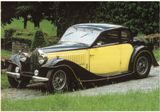
SPECIFICATION
Engine:
Staight eight; 72x100mm;
3527cc Twin OHC;
Max power, 135 bhp At 4500rpm;
Transmission:
Four speed manual gearbox.
Suspension:
Front , Beam axle, semi-elliptic springs and Dampers.
Rear, Live axle Reversed quarter-elliptic springs and Dampers.
Brakes:
Drum brakes
Dimensions:
Wheelbase, 130 in (330 cm);
Track, Front, 53 in (135 cm);
Rear, same
Max speed:
Approx 96 mph (155 kmh)
|
Bugatti Type 57 1934/39
The Type 57 was perhaps the most popular to come out of the Molsheim factory, with versions from Grand Routiers to the out and out sports racing T57s and T57SC. Ettore Bugatti's son Jean was largely responsible for it's design which marked change. Bugatti still made fast cars, but they also offered comfortable travel.
Flexable Engine
Unveiled at the 1933 Paris Motor Show, the T57 was a replacement for the T49, and it retained the classic Bugatti chassis and suspension features (Ettore Bugatti vetoed advances in the front suspension). But even though the engine had the same internal dimensions as the T49 straight eight, it was largely a new twin OHC unit. It was refined and flexable, rated at 135 bhp in normal T57 form. There was a new four-speed gearbox in unit with the engine. The series 2 cars had detail improvements in 1937, while the series 3 cars that came a year later had hydraulic brakes and telescopic dampers in place of friction dampers
Grand Routier
The long wheelbase of the normal car gave coachbuilders opportunities to create some splendid sports and coupe bodies, and even saloon's. As well as some that were not altogether pleasing. In all, some 710 T57s were built before production ended in 1939, the year Jean Bugatti was killed in a road accident.
The "Coach Ventoux" bodywork (of 1935) was not the most handsome to be mounted on a T57 chassis, but the purity of line is maintained to the back of the engine compartment.
Photo Autopresse
MCMXCI, Edito-Service S.A. D1 078 02-18
|